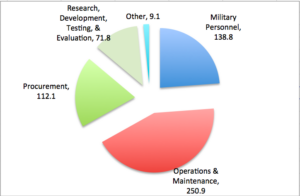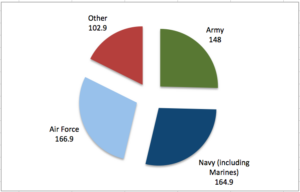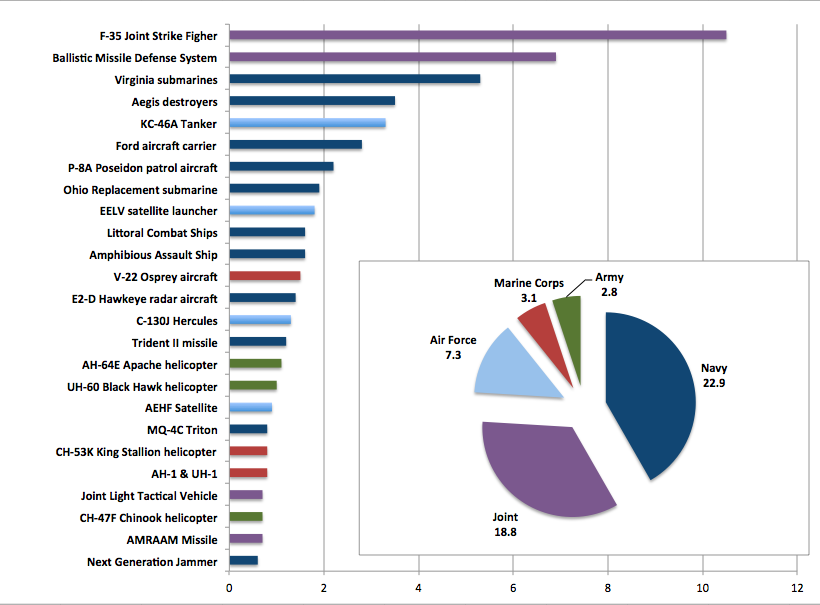2017 Budget: The Long, Slow Slog
Posted on

UPDATED: ADDS J-8 Readiness Comments; Sen. Reed Urging GOP To Let OMB Director To Testify
PENTAGON: On a grand strategic level, the Defense Department’s 2017 spending plan reorients the military to deter Russia and China. Down in the trenches, though, it’s a long, slow slog to rebuild the force for high-intensity conflict after 14 years of irregular warfare in the Islamic world — which isn’t actually ending — and three years of Budget Control Act caps. The effect is mostly immediately, painfully obvious in readiness, but long-term modernization suffers too.
[Click here for our complete coverage of the 2017 budget]

2017 budget by function, in $ billions
UPDATE BEGINS How long will it take to rebuild the readiness of American forces, whittled away by 15 years at war?
“It’s going to take time. It will be in the early portion of the next decade before we start to see regeneration rates exceeding where we need them to be,” the J-8, Lt. Gen. Anthony Ierardi, told Sydney during today’s budget Q and A. “It’s not as fast as we’d like.” UPDATE ENDS
Navy readiness, for example, is recovering from the 2013 sequester and years of frenetic deployments with its new Optimized Fleet Response Plan. On current funding levels, by 2018 all carriers, amphibious ships, and their escorts will be on OFRP. If that funding continues, then by 2021, the Navy will have rebuilt its readiness enough to have two carriers deployed, on average, at any given time and three more ready for “surge” deployment in a crisis. That’s five years from now — and it’s still short of the old Navy standard of keep three carriers deployed. So expect more “carrier gaps” in the Persian Gulf when no carrier is on hand.

Service shares of the 2017 budget, in $ billions
The Air Force, for its part, expects readiness to stay at current levels through 2019. Only then will several years of investments start to pay dividends — training technical experts such as pilots, space operators, and cyber warriors is a slow process — and allow readiness to climb, albeit slowly. By 2028 to 2030, a decade-and-a-half from now, the Air Force expects to achieve adequate “full spectrum readiness” for high-intensity war.
Readiness is the Army’s No. 1 priority — at the expense of modernization — but one official document says bluntly that “the rebuilding of Army core readiness has plateaued.” For example, the Army is funded for 19 of its capstone brigade-level wargames at the Combat Training Centers in 2015, 2016, and 2017, with no increase — although more and more of these wargames are devoted to high-intensity conflict. Army-wide, the 2017 budget actually decreases large-unit collective training.
 Modernization Blues
Modernization Blues
The Pentagon has outlined an ambitious Third Offset Strategy to revolutionize the military, but this budget only sows the seeds for that long-term effort. Most modernization programs are feeling pretty cramped.
Even the Air Force’s vaunted F-35A, the largest variant of the largest program in Pentagon history, is giving up five aircraft. Overall, “We simply can’t afford” what we need to buy, says an Air Force document.
But it’s Army modernization that suffers most, as always in recent years. The service’s procurement budget drops by almost a billion dollars, from $18.5 billion to $17.6 (counting both base budget and overseas contingency operations funds), with helicopters taking the hardest hit.
The Navy is arguably the best off, having gotten back one of the Littoral Combat Ships that Secretary Ash Carter wanted to cut. The 2017 shipbuilding budget buys seven major vessels: two LCS, two destroyers, two attack submarines, and a big-deck amphibious assault ship. It also starts advanced procurement of long-lead items for what will be the Navy’s most costly program, the replacement for the Ohio-class ballistic missile submarine. Meanwhile, the Navy aviation budget plan increases both F-35Cs and F/A-18E/Fs over the next five years.
Thanks to last fall’s budget deal, the ’17 budget is $582.7 billion, some $14 billion over the Budget Control Act caps. But the Pentagon isn’t just paying to sustain today’s force and build tomorrow’s: It’s also repairing the damage of yesterday. That looks to be a long march indeed. And a hard one. Senior Republican lawmakers including House Armed Services Chairman Mac Thornberry have already signaled they are unhappy with the Pentagon budget request and plan to push for substantially more funding for the Overseas Contingency Operations funding. And, as the New York Times reported yesterday:
“Breaking with a 41-year-old tradition, the Republican chairmen of the House and Senate budget committees announced that they would not even give the president’s budget director, Shaun Donovan, the usual hearings in their panels this week.”
Colin heard grumblings from Republican quarters last week about Defense Secretary Ash Carter not appearing for the so-called posture hearings immediately after the budget’s release. HIs spokesman, Peter Cook, reasonably pointed out that Carter was attending a major NATO meeting and an important anti-ISIL coalition meeting and would be sitting down with Congress soon after his return. He left for Brussels today.
UPDATE BEGINS: Sen. Jack Reed, top Democrat not he Senate Armed Services Committee, urged the GOP to reconsider in a Tuesday statement:
“I urge Republican leaders to reconsider their decision to break with decades of tradition and allow Office of Management and Budget Director Shaun Donovan to testify before Congress on this proposal. Even if they disagree with the President, they shouldn’t shut the process down. The American people deserve better.”

Largest acquisition programs (both procurement and RDTE), by size and service, in $ billions
Colin contributed to this story.
Subscribe to our newsletter
Promotions, new products and sales. Directly to your inbox.
